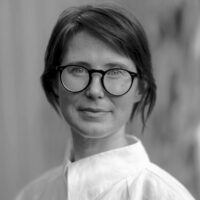
Photo by Sarah Pannell.
PHOTO People – Pippa Milne joins PHOTO 2024's curatorial team
1.5.23
Following positions as Curator at Centre for Contemporary Photography and the Senior Curator at Museum of Australian Photography (formerly Monash Gallery of Art), Pippa Milne has built a reputation as one of Australia’s leading curators.
As she joins Photo Australia’s curatorial team, we ask Pippa about her career highlights to date, what she is looking forward to in her new role, and what advice she would pass on to the next generation of curators.
Hello Pippa, please begin by telling us something about yourself that’s not on your CV.
I used to live in Italy and this was where I first felt how much there was to be gained from the unfamiliar. Language, geography, school systems – they felt a long way from Auckland, New Zealand and it maybe stretched my sense of self a bit.
What have been your career highlights to date?
Highlights that come to mind always revolve around artists and my chance to see exhibitions come to life around their work – for instance, the time spent with Hoda Afshar working towards her solo exhibition, Speak the Wind in 2022, was filled with the types of conversations and idea swapping that really sustains you as a curator.
Another highlight was working with Raphaela Rosella on the presentation of her series You’ll know it when you feel it as part of Not standing still (presented as part of PHOTO 2021). This was an incredible body of work that brought to light aspects of young motherhood and the Prison Industrial Complex made over a number of years. It was made in collaboration with the artist’s identical twin and friends, Tricia, Tammara, Rowrow, Nunjul, Mimi, Gillianne, Dayannah and their families. There was a lot to negotiate in making that project feel right and the result was something that people spent a lot of time absorbing and revisiting, which was really rewarding.
![2_Hoda Afshar, from the series Speak the Wind (2015-2020). Courtesy of the artist and Milani Gallery, Brisbane Image: Hoda Afshar, from the series [Speak the Wind] (2015-2020). Courtesy of the artist and Milani Gallery, Brisbane.](https://photo.org.au/api/wp-content/uploads/2022/02/2_Hoda-Afshar-from-the-series-Speak-the-Wind-2015-2020.-Courtesy-of-the-artist-and-Milani-Gallery-Brisbane-161x200.jpg)
Image: Hoda Afshar, from the series Speak the Wind (2015-2020). Courtesy of the artist and Milani Gallery, Brisbane.
Why did you decide to focus your curatorial practice to date on photography?
I spent a lot of my time in the darkroom as a school student, but my interest in curating photography really came with the discovery of Centre for Contemporary Photography (CCP) when I moved to Melbourne from Auckland. At CCP, I learnt a lot from those around me, both artists and curators, and photography seemed like a medium that was incredibly malleable, democratic and allowed for exploration of so many different things – a repository of memory, a means of questioning the status quo and a way of speculating towards the future.
You have already played a role in shaping PHOTO 2021 and PHOTO 2022 as a Curatorial Advisor – including helping select artists through the Open Call – and in your position at Monash Gallery of Art. What have you most enjoyed about the first two festivals?
I think the thing that I’ve most enjoyed about PHOTO as it has taken its place within the Australian arts scene is the focus that it’s brought to Melbourne’s photography scene. There were already such fantastic things happening in photography here – artists working at truly fascinating projects; institutions (big and small) embracing photography – and PHOTO was able to bring all of that together so that it felt momentous and fulsome. I was so energised by the way that it held up photography for others to see, bringing names like Zanele Muholi and Cindy Sherman together with Australian artists like Hayley Millar Baker and Hoda Afshar so that internationals and locals were conversant, so to speak.
We are thrilled you will be working with us to curate PHOTO 2024’s outdoor program. What are you looking forward to about this new role? And what do you see as the biggest challenge shifting working on gallery exhibitions to outdoor installations?
I guess the answer to these two questions is kind of the same – I’m so looking forward to working at a large scale, thinking about the ways that a very broad audience encounters and absorbs photography in this context, offering big and small moments of engagement, and seeing it all play out in a condensed timeframe… but this also poses the challenge of working in new ways and finding new solutions. It’s daunting and motivating at once.
And finally, what piece of advice would you offer someone who is thinking about a career as a curator?
To start now. It never seems like a good time, and there’s never the perfect set of circumstances, but if you want to curate, just start. See shows, put together exhibitions of your own (this needn’t be in a white cube gallery, it could be in unorthodox spaces) and talk to people whose work interests you, both artists and curators. A great way to find out more about how curators work is by volunteering at institutions. I realise that not everyone can volunteer, but I’ve found that the conversations I’ve had, the experience I’ve gained and the support I’ve received from my time as a volunteer has had a real impact on how I have worked over the years.